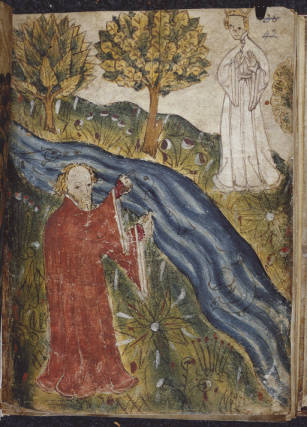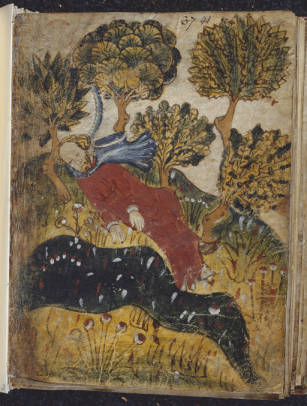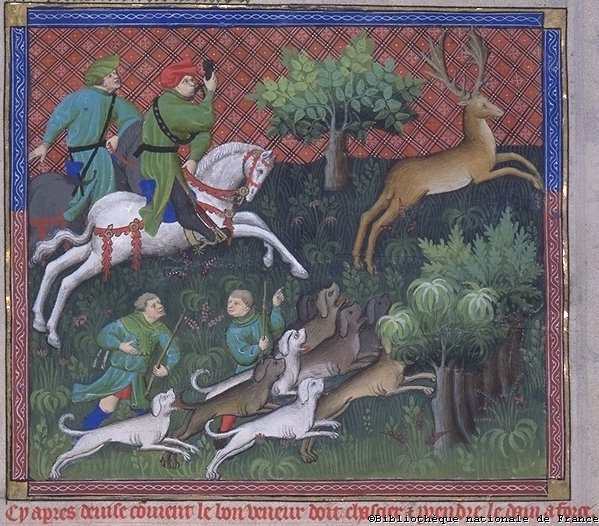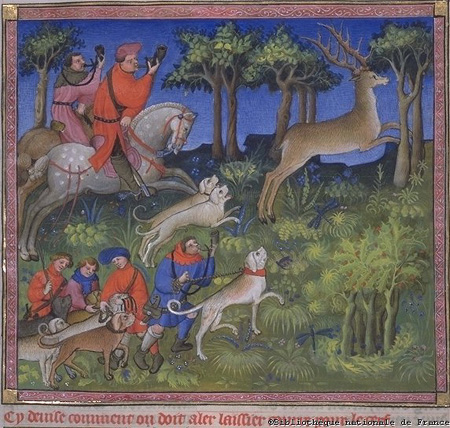[This post, part of an effort to merge our undergraduate and graduate blogs, was written in response to an essay prompt for Kathryn Kerby-Fulton's undergraduate course on "Chaucer's Biggest Rivals: The Alliterative Poets." It comes from the former "Medieval Undergraduate Research" website.]
My translation of Pearl (section XX, lines 1201-13):
“To please the Prince and straighten sight,
It is very easy to the good Christian.
For I have found Him, both day and night
A God, a Lord, a friend most fine.
On this hill I felt this rite
For pity of my pearl divine;
And unto God I committed with might
In Christ’s dear blessing and mine,
That in the form of bread and wine
The priest shows us every day.
He grants us to be His homely hine
And precious Pearl to Him as she may.
Amen.”
Original Text:
“To pay þe Prince oþer sete saȝte
Hit is ful eþe to þe god Krystyin;
For I haf founden hym, boþe day and naȝte,
A God, a Lorde, a frende ful fyin.
Ouer þis hyul þis lote I laȝte,
For pyty of my perle enclyin,
And syþen to God I hit bytaȝte
In Krysteȝ dere blessyng and myn,
Þat in þe forme of bred and wyn
Þe preste vus scheweȝ vch a daye.
He gef vus to be his homly hyne
Ande precious perleȝ vnto his pay.
Amen.”
In the final stanza of Pearl, the unknown poet must not only continue to employ all of the restrictions set up by the form he employs throughout the poem, but must also effectively conclude and tie together the poem in its entirety. As such, the overall successfulness of this passage, on its own and in the context of Pearl as a whole, is remarkable. The poet retains the rhyme scheme, stanza structure, and mood, all while injecting some extremely important—and telling—bits of information through wordplay and repetition.
When considering the conclusion to Pearl, the reader will undoubtedly ask a version of this question: “Has the narrator learned and progressed from this experience?” It is easy to respond both “yes” and “no.” Yes, because the narrator, in his own words, has “bytaghte / In Krystes dere blessyng” (XX.1207-8). Altenatively, “no,” because just moments before the conclusion he is “kaste of kythes that lastes aye” (XX.1198). As a result of these conflicting positions occurring only ten lines apart, deeper analysis is required to answer this loaded question.
Luckily, the poet inserts clues into the end of this final stanza to help his audience understand where he might stand on the issue of the narrator’s growth. The first comes in the form of a weighted bit of wordplay in lines 1211 and 1212, “He gef uus to be His homly hyne / And precious perles unto His pay.” Here, “gef” can mean “gives,” “grants,” or “bequeaths.” While all conveying similar ideas, the slight differences showcase the amount of clarity the narrator has to his and Pearl’s existences. In the first sense of “gef,” the narrator expresses the seemingly arbitrary “give and take” nature of the Lord. Much like in the beginning of the poem, this is the narrator’s non-understanding of the situation and his distress over his daughter being taken from him. This would suggest that he has not progressed.
However, the second two of the aforementioned three meanings of “gef” insinuate that the narrator has in fact developed beyond the poem’s onset as a result of his spiritual experience and verbiage. In his understanding that the Lord “grants” the people on earth to serve him, the narrator shows that he realizes the honor and importance of living in God’s grace. It transforms the previous “give and take” nature, first assumed to be the narrator’s outlook, into a nature of allowance. God allows the narrator to make the profound sacrifice of letting go of his daughter, and the narrator, after an understandable period of grieving, ultimately comes away as thankful.
This also plays through the “bequeath” meaning of “gef;” this language connotes a transferal of ownership. As such, a “bequeath” reading illustrates that the narrator has acceptingly given his daughter over to God. With these readings illuminating the levels of understanding the narrator develops over the course of the poem, it is evident that he has learned from the endeavors across Pearl.

Considering the loaded meaning behind this solitary word in the original version, while Marie Borroff’s translation often excels structurally, the demands of alternative Middle English definitions make Pearl difficult to translate completely. Take Borroff’s translation of lines 1211 and 1212: “O may we serve Him well, and shine / As precious pearls to His content.” Though the clear metaphorical use of “pearls” and her adherence to the key phrases of the original come through strongly, gone is the weight of the epiphany-like “He gef us to be His…” However, as the difficulty of the original’s style is so demanding, it is a compromise that, likely, had to be made.
In translating, Borroff could have either tried to mirror the original poem’s style or shoot for exact accuracy in meaning—it probably is impossible to replicate both together, and any attempt would likely come up short on both ends. Therefore, critiquing Borroff’s translations should be done with the guidelines of the original’s form in mind. As the translator lays out in her introduction, “One of the most striking and significant aspects of the poem is its conformity to an all-encompassing and highly elaborate design.” Her adherence to the complete concatenation (“Pearl, that a prince is well content,” “As precious pearls to His content”—the first and final lines of the poem), using alliteration in moments of heightened drama (“His gifts gush forth like a spring in spate” (XI.1)), and unwavering rhyme scheme is remarkable:
Flash in winter form frosty space;
For every one was a gem to praise,
A sapphire or emerald opulent
That seemed to set the pool ablaze,
So brilliant their embellishment. (II.116-120)
This strict design, as Borroff refers to it, is the most important part of the poem; to honor it as closely as possible is necessary in a modern English translation, especially if this might be the only way in which some readers could be exposed to it.
For the most part, by conforming to the original Pearl’s design, Borroff retains much of the experience of reading Pearl in Middle English. The ababababbcbc rhyme scheme and alliterative passages convey the fairytale-like flow. The employment of the linking words and phrases matches the spiritual overtones of not only the poem’s plot, but also its style. The repetition, along with the poem’s ending in “Amen” imply that the poem is meant to be a prayer, read over and over. For example, the concatenation that occurs between the last line and the first line tie the poem together into a potentially never-ending circular narrative. By keeping this in, Borroff portrays much more than she would have if she attempted to only translate for as much accuracy as possible with each individual word. Instead, Borroff’s translation focuses on aesthetic accuracy and presents much more of Pearl’s most significant qualities.
Matthew McMahon
University of Notre Dame




